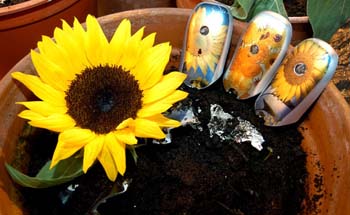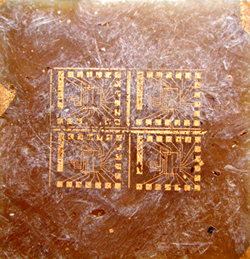|
Scientists are coming up with new ways of recycling mobile phones as well as ingenious materials for making the next generation.
by Katherine Nightingale
 Photo courtesy
of Fonebak
Photo courtesy
of Fonebak
Some mobile
phone companies have schemes whereby old mobile phones are
refurbished and sent to developing countries.
|
|
We live in an age of disposability. Americans throw away 25 billion styrofoam coffee cups a year and Britons throw away enough rubbish every hour to fill the Royal Albert Hall. But it's not just food scraps and packaging that we throw away, recently attention has turned to electronics and the icon of the modern age: the mobile phone. Every year, 15 million phones in the UK are replaced for newer models. Although some phones are passed on to friends, and under some schemes are sent to developing countries for use in areas with no landline infrastructure, many are simply thrown away. The consequences are not only wasteful but potentially dangerous, and as a result, scientists are coming up with new ways to recycle mobiles and ingenious materials for making the next generation.
Although phones seem to be made from harmless plastic, they have many nasty chemicals hidden inside them. Their plastic covers contain flame retardant additives that can give rise to toxic dioxins if incinerated, the cadmium in nickel-cadmium batteries is known to be toxic and carcinogenic and there are other toxic metals in the circuit board. When consigned to a landfill, phones could remain there for hundreds of years leaching their toxic chemicals into the soil and potentially into water supplies. Recycling phones means that toxic substances can be removed and precious metals such as gold and silver can be recovered and used again in other products.
Anna Robson, a scientist at Imperial College London, is looking into novel ways to recover metals from circuit boards. In most recycling plants, electronic waste is shredded and then separated into different types: plastic, glass and circuit boards. Anna has developed a system where shredded circuit boards are put into a large bath of acidic salty water. This dissolves the metals from the plastic backing so that they can be disposed of safely. The metals are then removed from the tank by passing an electrical current through the liquid. The current causes the metals to collect on metal beads in the tank and by changing the voltage, Anna can choose the metal she wants to precipitate. "It lets recyclers remove poisonous metals as well as precious ones, at virtually no extra cost. So there's no excuse for sending nasty stuff to landfill", says Anna. Recovering useful metals is of no small significance either, if we threw away all upgraded phones every year, we'd be kissing goodbye to 3750kg of silver and 600kg of gold.
 Photo
courtesy of The University of Warwick
Photo
courtesy of The University of Warwick
The Sunflower phone can be planted when you're done with it to produce a sunflower plant.
|
Recycling is all very well, but many people think it makes more sense to design phones that are less harmful in the first place. Kerry Kirwan, an engineer from the University of Warwick, has been working with plastics manufacturers to come up with a phone cover made of biodegradable plastic - an alternative to the usual plastics that can last hundreds of years in a landfill When buried, the biodegradable plastics break down into natural minerals. This is useless if we forget to plant our phone covers though, so as an incentive Kerry has incorporated a sunflower seed into the cover. When planted, microorganisms in the soil break down the plastic and provide nutrients for the sunflower to grow - giving you a sunflower plant in exchange for your phone. "The great thing about this plastic is that it doesn't biodegrade in a normal working environment - it has to have very special conditions to start the process," says Kerry. "This means that you can use it in everyday life but the minute you pop it in the ground it begins to break down."
 Courtesy of Richard Wool
Courtesy of Richard Wool
Credit: Dawn Marie Fiore
This phone
circuit board is made of soya oil and chicken feathers.
|
It's not just the plastic in phone covers that poses a problem; phone circuit boards made from glass fibre and oil-based plastics are hard to recycle and very wasteful to produce in the first place. Richard Wool, an engineer from Delaware University, has come up with a new formula for circuit boards - a combination of soya oil and chicken feathers. Not only are both these materials entirely natural and renewable, but if used, the technique could also find a use for unwanted chicken feathers. In the United States, wasted feathers weigh in at a billion kilograms a year, which is a lot of feathers to burn or bury. Roger Wise, a British materials scientist, has also suggested making circuit boards out of a new substance: pasta, or lasagne, to be precise. Roger eventually wants to use plant material to produce circuit boards, a move that could lead to a 'closed loop' for circuit board production: the products of the degradation of old circuit boards could be used to feed plants and make new ones.
Yet this still leaves a burning question: why do we have such a desire to keep up with the trends? If we didn't, we'd only be replacing our mobiles when necessary instead of every 12 to 18 months and there would be less of a need to make circuit boards out of chicken feathers. Perhaps producing timeless designs and methods of upgrading a phone's function without replacing a whole handset may be more effective. Although I would quite like a sunflower in my garden.
For more information:
Science Museum: Dead Ringers
http://www.sciencemuseum.org.uk/antenna/deadringers/
BBC News - Biodegradable phone is developed
http://news.bbc.co.uk/1/hi/england/coventry_warwickshire/4056687.stm
|
